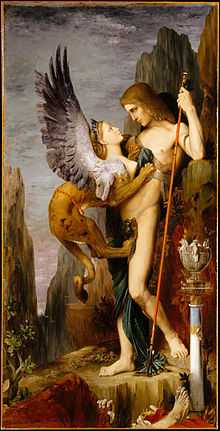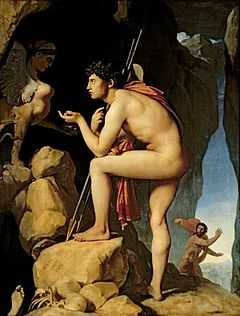Oedipus and the Sphinx



Oedipus and the Sphinx is an 1864 oil on canvas painting by Gustave Moreau that was first exhibited at the French Salon of 1864 where it was an immediate success.[1] It is now in the Metropolitan Museum of Art.[2] The work was a fresh treatment of the established subject of the meeting between Oedipus and the Sphinx on the road to Delphi.
Subject matter
The painting depicts Oedipus meeting the Sphinx at the crossroads on his journey between Thebes and Delphi. Oedipus must answer the Sphinx's riddle correctly in order to pass. Failure means his own death and that of the besieged Thebans. The riddle was: "What walks on four feet in the morning, two in the afternoon and three at night?". Oedipus answered: "Man: as an infant, he crawls on all fours; as an adult, he walks on two legs and; in old age, he uses a walking stick". Oedipus was the first to answer the riddle correctly and, having heard Oedipus' answer, the Sphinx was astounded and inexplicably killed herself by throwing herself into the sea. Oedipus thereby won the freedom of the Thebans, the kingdom of that city and a wife Jocasta, who it was later revealed was his mother.[3]
Style and antecedents
In this work Moreau deliberately rejects the realism and naturalism in vogue in mid nineteenth century France, instead adopting a deliberately archaic painting style and mythological subject matter.[1] Moreau had sketched Ingres' 1808 Oedipus and the Sphinx in Paris and that is a likely source for his version of the story.[1] Ingres also painted a later version (c. 1826)[3] which is now in the National Gallery, London, but it is uncertain whether Moreau saw that work. The influence of Italian Renaissance master Andrea Mantegna has also been detected in Moreau's version.[1]
Unlike Ingres' version where Oedipus appears as the dominant figure with the Sphinx on the defensive and partly obscured, in Moreau's version the Sphinx is on the offensive, clawing at Oedipus whose victory in the encounter does not yet seem assured. Indeed, other works by Moreau often feature victorious sphinxes atop a mound of victims.[4]
The Sphinx in the painting may be seen as a form of femme fatale, a common theme in late nineteenth century arts and particularly of Symbolist painting. Ragnar von Holten has argued that the subject depicts not only the battle between good and evil, but also between the sexes, and that the opening poem of Buch der Leider by Heinrich Heine was the source for the idea of the painting. In that poem the Sphinx triumphs over Oedipus.[4] In a Freudian interpretation, it has been argued that the Sphinx represents the castrating effect of Moreau's mother that he has seeking to escape. At the time the painting was created, Moreau's father had recently died.
By contrast, Henri Dorra has suggested that the poses of the sphinx and Oedipus are derived from the Greek etymological meaning of the word sphinx, which is to clutch, embrace, or cling to. Dorra notes that a paper on the subject by Michel Bréal had been published in 1863, the year before the work was painted. Dorra also draws attention to the symbolic meaning of some of the elements in the picture, which could have autobiographical aspects, and the possible derivation of the treatment of the subject from the design of a Bithynian coin of Nicomedes II depicting Zeus leaning on a staff with an eagle on his right.[5]
The intense gaze shared between the two has been seen as characteristic of Moreau "who again and again suggests an ambiguous mirror-image, two aspects, two abstract entities that confront each other and recognize each other all too well".[6]
Reception
The painting was an immediate success at the Salon. E. de Sault wrote in the Temps of Moreau's "devotion to the old masters, and the knowledge and application of sound principles and traditions. The painter of Oedipus, obscure and unknown yesterday, and who will be famous tomorrow".[7]
The only serious criticism levelled at the work was that its figures might have been too inspired by the work of Mantegna. Critic Paul de Saint-Victor warned that Moreau should extricate himself from the "harsh embrace" of Mantegna in order to realise his full potential.[7]
Another critic observed that a Greek sphinx, half-woman and half-vulture, was shown, rather than an Egyptian seated sphinx, but felt that whereas Ingres had presented a modern Oedipus, Moreau had better interpreted the classical Oedipus.[8]
Jules Claretie commented that it was drawn like a Mantegna but as poetic as a Leonardo da Vinci.[9]
After the Salon, Moreau quickly gained a reputation for eccentricity. One commentator said Moreau's work was "like a pastiche of Mantegna created by a German student who relaxes from his painting by reading Schopenhauer".[10]
History
The painting was first sold by the artist in 1864 to Prince Napoléon Bonaparte, who had a reputation as a discerning connoisseur, and paid a full 8000 francs for the work.[7] It was then sold in 1868 to Paul Durand-Ruel, and then in the same year to William H. Herriman of Rome[1] who gave it to the Metropolitan Museum of Art in 1920[2] where it is one of the few important Moreau paintings outside France.[11]
On his death, Moreau left all of his extant paintings to the French nation where they formed the basis for the subsequent Gustave Moreau Museum.[11]
References
- ↑ 1.0 1.1 1.2 1.3 1.4 Gustave Moreau: Oedipus and the Sphinx. Heilbrunn Timeline of Art History, Metropolitan Museum of Art, 2014. Retrieved 30 June 2014.
- ↑ 2.0 2.1 Oedipus and the Sphinx Metropolitan Museum of Art, 2014. Retrieved 26 June 2014.
- ↑ 3.0 3.1 Oedipus and the Sphinx The National Gallery, 2014. Retrieved 30 June 2014.
- ↑ 4.0 4.1 "Gustave Moreau Through the Eyes of Succeeding Generations" by Jose Pierre in Jean Paladilhe and Jose Pierre (1972) Gustave Moreau. Translated by Bettina Wadia. London: Thames and Hudson, pp. 94-97. ISBN 0500090831
- ↑ Dorra, Henri. "The Guesser Guessed: Gustave Moreau's Œdipus." Gazette des beaux-arts, 81 (March 1973), pp. 129–140.
- ↑ Ashton, Dore. (1961) Odilon Redon, Gustave Moreau, Rodolphe Bresdin. Exh. cat. New York: Museum of Modern Art, pp. 113, 115, 179, no. 175, ill.
- ↑ 7.0 7.1 7.2 "Gustave Moreau: His Life and Work" by Jean Paladilhe in Jean Paladilhe and Jose Pierre (1972) Gustave Moreau. Translated by Bettina Wadia. London: Thames and Hudson, pp. 25–26. ISBN 0500090831
- ↑ "Old Noll". "Des tendances de l'art contemporain, à l'occasion de l'Exposition des beaux-arts de 1864." Annales de la charité (Revue d'économie chrétienne) 6 (May 1864), pp. 883–902.
- ↑ "Salon de 1864: Le salon des refusés." L'Artiste, 2 (30 June 1864), p. 4.
- ↑ Lucie-Smith, Edward. (1972) Symbolist Art. London: Thames & Hudson, p. 63. ISBN 0500201250
- ↑ 11.0 11.1 Tinterow, Gary. Compiled with Susan Alyson Stein & Barbara Burn. (1993). The New Nineteenth-Century European Paintings and Sculpture Galleries. New York: Metropolitan Museum of Art. p. 49.
External links
 Media related to Gustave Moreau at Wikimedia Commons
Media related to Gustave Moreau at Wikimedia Commons Media related to Sphinxes at Wikimedia Commons
Media related to Sphinxes at Wikimedia Commons
| ||||||||||||
_-_Zelfportret_(1864)_-_28-02-2010_13-37-05.jpg)